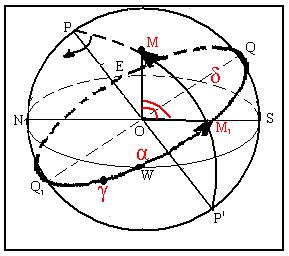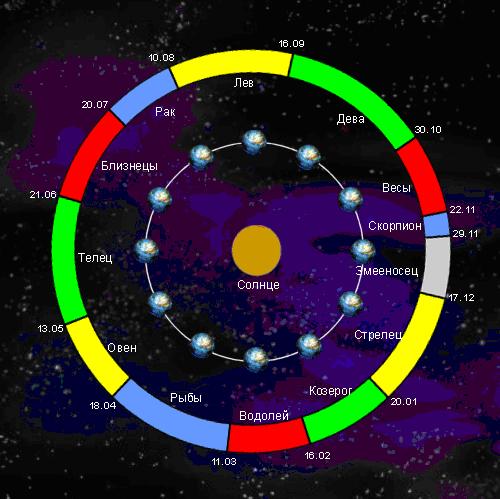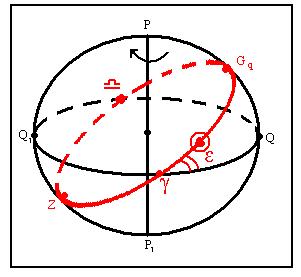There are orioles in the forests, and longitude in vowels
In tonic verses the only measure
But only once a year it is spilled
In nature, duration
As in Homer's metric.
As if this Day gapes like a caesura:
Peace in the morning
And difficult lengths
Ox in the pasture
And golden laziness
To extract wealth from the reed
whole note.
O. Mandelstam
Lesson 4/4
Subject: Change in the appearance of the starry sky during the year.
Target: He will get acquainted with the equatorial coordinate system, the visible annual movements of the Sun and the types of the starry sky (changes during the year), learn how to work according to the PKZN.
Tasks
:
1. educational: to introduce the concepts of the annual (apparent) movement of the luminaries: the Sun, the Moon, stars, planets and types of the starry sky; ecliptic; zodiac constellations; points of equinox and solstice. The reason for the "delay" of climaxes. Continue the formation of the ability to work with PKZN - finding the ecliptic, zodiac constellations, stars on the map by their coordinates.
2. nurturing: to promote the formation of the skill of identifying cause-and-effect relationships; only a thorough analysis of the observed phenomena makes it possible to penetrate into the essence of seemingly obvious phenomena.
3. Educational: using problem situations, bring students to an independent conclusion that the view of the starry sky does not remain the same throughout the year; updating the students' knowledge of working with geographical maps, to form the skills and abilities of working with PKZN (finding coordinates).
Know:
1st level (standard)- geographical and equatorial coordinates, points in the annual motion of the Sun, the inclination of the ecliptic.
2nd level- geographic and equatorial coordinates, points in the annual motion of the Sun, the inclination of the ecliptic, directions and causes of the displacement of the Sun above the horizon, zodiacal constellations.
Be able to:
1st level (standard)- set according to the PKZN for various dates of the year, determine the equatorial coordinates of the Sun and stars, find the zodiac constellations.
2nd level- set according to the PKZN for various dates of the year, determine the equatorial coordinates of the Sun and stars, find the zodiac constellations, use the PKZN.
Equipment: PCZN, celestial sphere. Geographic and star map. Model of horizontal and equatorial coordinates, photos of starry sky views at different times of the year. CD- "Red Shift 5.1" (the path of the Sun, Change of seasons). Video film "Astronomy" (part 1, fr. 1 "Star landmarks").
Interdisciplinary communication: Daily and annual movement of the Earth. The moon is a satellite of the Earth (natural science, 3-5 cells). Natural and climatic patterns (geography, 6 cells). Circular motion: period and frequency (physics, grade 9)
During the classes:
I. Student survey (8 min). You can test on the Heavenly sphere N.N. Gomulina, or:
1. At the blackboard
:
1. Celestial sphere and horizontal coordinate system.
2. The movement of the luminary during the day and the culmination.
3. Translation of hourly measure into degrees and vice versa.
2. 3 people on cards
:
K-1
1. In which side of the sky is the luminary with horizontal coordinates: h=28°, A=180°. What is its zenith distance? (north, z=90°-28°=62°)
2. Name three constellations visible today during the day.
K-2
1. In which side of the sky is the star, if its coordinates are horizontal: h=34 0 , A=90 0 . What is its zenith distance? (west, z=90°-34°=56°)
2. Name three bright stars that we see during the day.
K-3
1. In which side of the sky is the star, if its coordinates are horizontal: h=53 0, A=270 o. What is its zenith distance? (east, z=90°-53°=37°)
2. Today the star is in its upper climax at 21:34. When is its next lower, upper climax? (after 12 and 24 hours, more precisely after 11 h 58 m and 23 h 56 m)
3. Others(on their own in pairs while they answer at the blackboard)
a) Convert to degrees 21 h 34 m, 15 h 21 m 15 s. resp = (21. 15 0 +34. 15 "=315 0 +510" =323 0 30", 15 h 21 m 15 s =15. 15 0 +21. 15 "+15. 15" =225 0 + 315 "+ 225"= 230 0 18"45")
b) Convert to hourly measure 05 o 15 "13 o 12" 24 "resp = (05 o 15" = 5 . 4 m +15 . 4 c \u003d 21 m , 13 o 12 "24" = 13 . 4 m +12 .4 s +24.1/15 s =52 m +48 s +1.6 s =52 m 49 s.6)
II. New material (20 min) Video film "Astronomy" (part 1, fr. 1 "Star landmarks").
b) The position of the luminary in the sky (celestial medium) is also uniquely determined - in equatorial coordinate system, where the celestial equator is taken as a reference point
. (equatorial coordinates were first introduced by Jan Havelia (1611-1687, Poland), in a catalog of 1564 stars compiled in 1661-1687) - an atlas of 1690 with engravings and is now used (textbook title).
Since the coordinates of the stars do not change for centuries, therefore, this system is used to create maps, atlases, catalogs [lists of stars]. The celestial equator is a plane passing through the center of the celestial sphere perpendicular to the axis of the world.
 |
points E-east, W-west - the point of intersection of the celestial equator with the points of the horizon. (Points N and S come to mind). |
| Declension circle - a large circle of the celestial sphere passing through the poles of the world and the observed luminary (points P, M, P "). | |
|
Equatorial coordinates: |
c) The annual movement of the Sun. There are luminaries [Moon, Sun, Planets] whose equatorial coordinates change rapidly. The ecliptic is the apparent annual path of the center of the solar disk across the celestial sphere.
Tilt to the plane of the celestial equator is currently at an angle 23 about 26", more precisely at an angle: ε = 23°26'21", 448 - 46", 815 t - 0", 0059 t² + 0", 00181 t³, where t is the number of Julian centuries that have elapsed since the beginning of 2000. This formula is valid for the next centuries. In longer periods of time, the inclination of the ecliptic to the equator fluctuates about the average value with a period of approximately 40,000 years. In addition, the inclination of the ecliptic to the equator is subject to short-period fluctuations with a period of 18.6 years and an amplitude of 18.42, as well as smaller ones (see Nutation).
The apparent motion of the Sun along the ecliptic is a reflection of the actual motion of the Earth around the Sun (proved only in 1728 by J. Bradley by the discovery of annual aberration).
|
space phenomena |
Celestial phenomena arising from these cosmic phenomena |
| Rotation of the Earth around its axis | Physical phenomena: 1) deviation of falling bodies to the east; 2) the existence of Coriolis forces. Displays of the true rotation of the Earth around its axis: 1) daily rotation of the celestial sphere around the axis of the world from east to west; 2) sunrise and sunset of the luminaries; 3) the culmination of the luminaries; 4) change of day and night; 5) daily aberration of the luminaries; 6) daily parallax of the luminaries |
| Rotation of the Earth around the Sun | Displays of the true rotation of the Earth around the Sun: 1) annual change in the appearance of the starry sky (apparent movement of heavenly bodies from west to east); 2) the annual movement of the Sun along the ecliptic from west to east; 3) change in the midday height of the Sun above the horizon during the year; a) change in the length of daylight hours during the year; b) polar day and polar night at high latitudes of the planet; 5) change of seasons; 6) annual aberration of the luminaries; 7) annual parallax of the stars |
 |
The constellations through which the ecliptic passes are called.
The number of zodiac constellations (12) is equal to the number of months in a year, and each month is indicated by the sign of the constellation in which the Sun is in that month. 13th constellation Ophiuchus excluded, even though the sun passes through it. "Red Shift 5.1" (the path of the Sun). |
|
|
|
| - vernal equinox. March 21
(day equals night). Sun coordinates: α ¤ =0 h, δ ¤ =0 o The designation has been preserved since the time of Hipparchus, when this point was in the constellation ARIES → now it is in the constellation FISH, In 2602 it will move into the constellation AQUARIUS. |
|
| -summer solstice. June, 22
(the longest day and the shortest night). Sun coordinates: α ¤ =6 h, ¤ \u003d + 23 about 26 " The designation has been preserved since the time of Hipparchus, when this point was in the constellation of Gemini, then it was in the constellation of Cancer, and since 1988 it moved into the constellation of Taurus. |
|
 |
- autumnal equinox. 23 September
(day equals night). Sun coordinates: α ¤ =12 h, δ tsize="2" ¤ =0 o The designation of the constellation Libra was preserved as the designation of the symbol of justice under the emperor Augustus (63 BC - 14 AD), now in the constellation Virgo, and in 2442 it will move to the constellation Leo. |
| - winter solstice. December 22
(the shortest day and the longest night). Sun coordinates: α ¤ =18 h, δ ¤ =-23 about 26" During the period of Hipparchus, the point was in the constellation of Capricorn, now in the constellation of Sagittarius, and in 2272 it will move into the constellation of Ophiuchus. |
 Although the position of the stars in the sky is uniquely determined by a pair of equatorial coordinates, the view of the starry sky at the place of observation at the same hour does not remain unchanged.
Although the position of the stars in the sky is uniquely determined by a pair of equatorial coordinates, the view of the starry sky at the place of observation at the same hour does not remain unchanged.
Observing the culmination of the luminaries at midnight (the Sun at this time is in the lower culmination with right ascension on a star different from the culmination), you can notice that on different dates at midnight, different constellations pass near the celestial meridian, replacing each other. [These observations at one time led to the conclusion about the change in the right ascension of the Sun.]
Let's choose any star and fix its position in the sky. At the same place, the star will appear in a day, more precisely, in 23 hours 56 minutes. A day measured relative to distant stars is called stellar
(to be quite precise, a sidereal day is the time interval between two successive upper climaxes of the vernal equinox point). Where do the other 4 minutes go? The fact is that due to the movement of the Earth around the Sun, it shifts for an earthly observer against the background of stars by 1 ° per day. To "catch up" with him, the Earth needs these 4 minutes. (picture on the left)
Each subsequent night, the stars shift slightly to the west, rising 4 minutes earlier. In a year it will shift by 24 hours, that is, the view of the starry sky will be repeated. The entire celestial sphere will make one revolution in a year - the result of a reflection of the revolution of the Earth around the Sun.
So, the Earth makes one rotation around its axis in 23 hours 56 minutes. 24 hours - the average solar day - the time of revolution of the Earth relative to the center of the Sun.
III. Fixing the material (10 min)
1. Work on the PKZN (in the course of presenting new material)
a) finding the celestial equator, ecliptic, equatorial coordinates, equinox and solstice points.
b) determining the coordinates of, for example, stars: Chapel (α Aurigae), Deneb (α Cygnus) (Capella - α=5 h 17 m, δ=46 o; Deneb - α=20 h 41 m, δ=45 o 17")
c) finding stars by coordinates: (α=14.2 h, δ=20 o) - Arcturus
d) find where the Sun is today, in which constellations in the fall. (now the fourth week of September is in Virgo, the beginning of September is in Leo, Libra and Scorpio will pass in November)
2. Optional:
a) The star culminates at 14:15. When is its next lower, upper climax? (after 11:58 and 23:56, that is, at 2:13 and 14:11).
b) AES flew across the sky from the starting point with coordinates (α=18 h 15 m, δ=36 o) to the point with coordinates (α=22 h 45 m, δ=36 o). Through which constellations did the satellite fly.
IV. Lesson summary
1. Questions:
a) What is the need to introduce equatorial coordinates?
b) What are the remarkable days of the equinox, solstice?
c) At what angle is the plane of the Earth's equator inclined to the plane of the ecliptic?
d) Is it possible to consider the annual movement of the Sun along the ecliptic as evidence of the revolution of the Earth around the Sun?
Homework:§ 4, questions assignment for self-control (p. 22), p. 30 (pp. 10-12).
(it is advisable to distribute this list of works with explanations to all students for a year).
Can be given an assignment 88 constellations
"(one constellation for each student). Answer the questions:
- What is the name of this constellation?
- At what time of the year is it best to observe it at our (given) latitude?
- What type of constellation does it belong to: non-ascending, non-setting, setting?
- Is it a northern, southern, equatorial, zodiac constellation?
- Name interesting objects of this constellation and indicate them on the map.
- What is the name of the brightest star in the constellation? What are its main characteristics?
- Using a mobile map of the starry sky, determine the equatorial coordinates of the brightest stars in the constellation.
Lesson designed members of the circle "Internet technologies" - Prytkov Denis(10 cells) and Pozdnyak Viktor(10 cells), Changed 23.09.2007
of the year
2. Ratings
| "Planetarium" 410.05 mb | The resource allows you to install the full version of the innovative educational and methodological complex "Planetarium" on the computer of a teacher or student. "Planetarium" - a selection of thematic articles - are intended for use by teachers and students in the lessons of physics, astronomy or natural science in grades 10-11. When installing the complex, it is recommended to use only English letters in folder names. | ||
| Demo materials 13.08 mb | The resource is a demonstration materials of the innovative educational and methodological complex "Planetarium". | Equatorial coordinate system 460.7 kb

